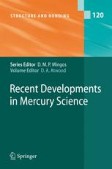Search
Search Results
-
Carbene Complexes of Heme Proteins and Iron Porphyrin Models
The possible formation of carbene complexes of cytochromes P450 enzymes in various metabolisms of xenobiotics is first described. In view of these...
-
Ferrocene–Peptide Bioconjugates
This chapter sketches an outline of ferrocene–peptide bioconjugates. A variety of ferrocene–peptide bioconjugates have been designed to induce...
-
Catalytic Nickel–Iron–Sulfur Clusters: From Minerals to Enzymes
The geochemical theory of the origin of life proposes that primordial, pre-biotic reactions were carried out in a metal-sulfide-rich environment...
-
Sequentially Palladium-Catalyzed Processes
Sequentially palladium-catalyzed reactions consist of combinations of identical, related, or significantly different palladium-catalyzed processes...
-
Structural Aspects of Layered Double Hydroxides
Layered double hydroxides (LDHs) have been known for a considerable time and have been widely studied. The basic features of their structure,...
-
n-Body Decomposition Approach to the Calculation of Interaction Energies of Water Clusters
A new methodology is proposed in which large basis set MP2-level calculations can be extended to water clusters with as many as 50 monomers. The...
-
Multiporphyrin ArraysAssembled Through Hydrogen Bonding
Although relatively weak in isolation, composite H-bonds can be used as an advantage for the assembly of relatively robust and well-defined arrays...
-
Axial Coordination to Metalloporphyrins Leading to Multinuclear Assemblies
The use of axial coordination to metalloporphyrins is discussed on the basis of constructing multinuclear complexes. Starting with single...
-
Poly(mercaptoimidazolyl)borate Complexes of Cadmium and Mercury
The coordination chemistry of bis- and tris(mercaptoimidazolyl)borate ligands with both main-group and transition metals is rapidly expanding....
-
Mercury Removal from Water
Mercury pollution in water is a serious threat to natural ecosystems. Various methods and technologies are in use to remove mercury from the...
-
Intermolecular Interactions via Perturbation Theory: From Diatoms to Biomolecules
This article is devoted to the most recent, i.e. taking place within the last few years, theoretical developments in the field of intermolecular...
-
Phase behavior of phytanyl-chained akylglycoside/water systems
The aqueous phase behavior of novel alkylglycosides, AGs, that have a 3,7,11,15-tetramethylhexadecyl (phytanyl) group as their hydrophobic part was...
-
Adsolubilization by mixtures of ionic and non-ionic surfactants
The adsolubilization of 2-naphthol by surfactant mixtures of ionic and non-ionic surfactants has been investigated for three systems; sodium dodecyl...
-
Salt-induced aggregation in cationic liposome suspensions
The simple salt-induced aggregation of small unilamellar dioleoyltrimethylammoniumpropane [DOTAP] vesicles is investigated by measuring the change in...
-
Enzymatic activity of lipase entrapped in CTAB/water/pentanol/hexane reverse micelles: a functional and microstructural investigation
The lipase VII (from Candida rugosa) activity was studied as a function of the content of pentanol and water in cethyltrimethylammonium bromide...
-
Perfluoropolyether carboxylic salts in micellar solution and O/W microemulsions
High purity laboratory-scale samples of Cl(C3F6O) n CF2COOX salts are examined for their micellization in water, with n...
-
Monolithic Silicon Light Sources
Monolithic silicon light sources (LEDs and lasers) could have a significant impact when integrated on silicon chips. After a general introduction to...
-
5. Simulation of Active and Nonlinear Photonic Nano-Materials in the Finite-Difference Time-Domain (FDTD) Framework
A numerical method is presented that unites three-dimensional finite-differnce time-domain (FDTD) computer simulations of active, nonlinear photonic...
-
Silicon Fundamentals for Photonics Applications
The many and diverse approaches to materials science problems have greatly enhanced our ability to engineer the physical properties of...
-
Monolithic Silicon Microphotonics
The technology evolution of optical interconnection is driven by the distance × product required for a given link. As such optical fiber deployment...
